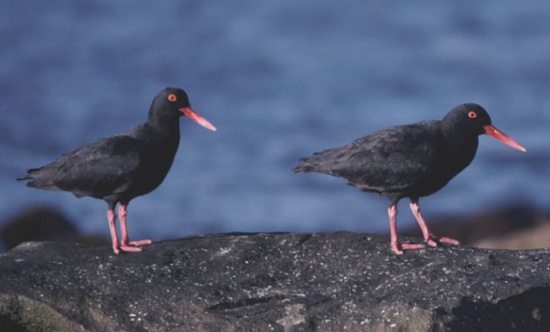m |
(text added) |
||
| Line 3: | Line 3: | ||
[[Image:African_Oystercatcher.jpg|thumb|550px|right|Photo by balticbird]] | [[Image:African_Oystercatcher.jpg|thumb|550px|right|Photo by balticbird]] | ||
==Identification== | ==Identification== | ||
| + | Length 42-45 cm, mass 582-835 g. Females larger than males. '''Adult''': Black with an orange-red bill, red eyes, an orange eye ring and pink legs and feet. '''Immatures''': Duller than adults, bill and eyes brown, eye ring narrow and legs and feet grey. | ||
==Distribution== | ==Distribution== | ||
| + | Coast of [[South Africa]], [[Namibia]] and southern [[Angola]]. | ||
==Taxonomy== | ==Taxonomy== | ||
| + | ''Haematopus moquini'' is monotypic. | ||
==Habitat== | ==Habitat== | ||
| + | Rocky shores and sandy beaches; sometimes estuaries, lagoons and coastal pans. | ||
| + | ==Status== | ||
| + | '''Near-threatened''': Human disturbance (on the mainland) and introduced predators and diseases (on islands) are the main threats to this species which is present in relatively low numbers (about 6000 individuals) and has a low rate of reproduction. | ||
==Behaviour== | ==Behaviour== | ||
| + | Forages in the intertidal zone, mainly for limpets and mussels; feeds both at night and during the day. Usually forages in pairs or small groups, and roosts communally. | ||
| + | |||
| + | '''Breeding''': The nest is a scrape in the ground above (but usually within 30 m of) the high-water mark. One to three eggs are laid September to April. | ||
| + | ==References== | ||
| + | Hockey PAR, Dean WRJ & Ryan PG (eds) 2005. Robert's Birds of Southern Africa, 7th edition. John Voelcker Bird Book Fund, Cape Town, South Africa. ISBN 0620340533 | ||
==External Links== | ==External Links== | ||
{{GSearch|Haematopus+moquini}} | {{GSearch|Haematopus+moquini}} | ||
[[Category:Birds]] [[Category:Haematopus]] | [[Category:Birds]] [[Category:Haematopus]] | ||
Revision as of 05:31, 14 February 2008
| This article is a stub. This article is short and lacking information. You can help the BirdForum Opus by expanding it. |
- Haematopus moquini
Identification
Length 42-45 cm, mass 582-835 g. Females larger than males. Adult: Black with an orange-red bill, red eyes, an orange eye ring and pink legs and feet. Immatures: Duller than adults, bill and eyes brown, eye ring narrow and legs and feet grey.
Distribution
Coast of South Africa, Namibia and southern Angola.
Taxonomy
Haematopus moquini is monotypic.
Habitat
Rocky shores and sandy beaches; sometimes estuaries, lagoons and coastal pans.
Status
Near-threatened: Human disturbance (on the mainland) and introduced predators and diseases (on islands) are the main threats to this species which is present in relatively low numbers (about 6000 individuals) and has a low rate of reproduction.
Behaviour
Forages in the intertidal zone, mainly for limpets and mussels; feeds both at night and during the day. Usually forages in pairs or small groups, and roosts communally.
Breeding: The nest is a scrape in the ground above (but usually within 30 m of) the high-water mark. One to three eggs are laid September to April.
References
Hockey PAR, Dean WRJ & Ryan PG (eds) 2005. Robert's Birds of Southern Africa, 7th edition. John Voelcker Bird Book Fund, Cape Town, South Africa. ISBN 0620340533




